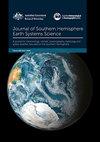Verification of moist surface variables over northern Australia in a high-resolution reanalysis (BARRA)
IF 3.6
4区 地球科学
Q1 Earth and Planetary Sciences
引用次数: 2
Abstract
Reanalyses are important tools for understanding past weather and climate variability, but detailed verification of near surface humidity variables have not been published. This is particularly concerning in tropical regions where humid conditions impact meteorology and human activities. In this study, we used screen level temperature and humidity data from a high-resolution atmospheric regional reanalysis, the Bureau of Meteorology Atmospheric high-resolution Regional Reanalysis for Australia (BARRA), validated against automatic weather stations (AWS) data for 32 sites across northern Australia. Overall, the BARRA data was reliable, with the time series from the AWS and BARRA being very highly correlated, but there were some seasonal and diurnally varying biases. The variability of the differences also changed from location to location and as a function of time of day and season, but much less than the biases. This variability was less than the ‘weather signal’ as evidenced by the high correlations. In particular, the amplitude of the diurnal cycle was overestimated, particularly in the dry (winter) season. In general, the differences in temperature were larger than those of the dew point temperature, and the wet bulb temperature had the least uncertainty. Overall, this study contributes to a better understanding of the effectiveness of reanalyses for examining the impact of moist variables on tropical climate variability.在高分辨率再分析中验证澳大利亚北部潮湿地表变量(BARRA)
再分析是了解过去天气和气候变率的重要工具,但对近地表湿度变量的详细验证尚未发表。这在潮湿条件影响气象学和人类活动的热带地区尤其令人担忧。在这项研究中,我们使用了来自澳大利亚气象局大气高分辨率区域再分析(BARRA)的高分辨率大气区域再分析的屏幕水平温度和湿度数据,并与澳大利亚北部32个站点的自动气象站(AWS)数据进行了验证。总体而言,BARRA的数据是可靠的,AWS和BARRA的时间序列高度相关,但存在一些季节性和日变化的偏差。差异的可变性也随地点的不同而变化,并作为一天中的时间和季节的函数,但比偏差小得多。这一变异性小于“天气信号”,高相关性证明了这一点。特别是,日循环的幅度被高估了,特别是在干燥(冬季)季节。总体而言,温度差异大于露点温度差异,湿球温度的不确定性最小。总的来说,这项研究有助于更好地理解再分析对检查潮湿变量对热带气候变率的影响的有效性。
本文章由计算机程序翻译,如有差异,请以英文原文为准。
求助全文
约1分钟内获得全文
求助全文
来源期刊

Journal of Southern Hemisphere Earth Systems Science
Earth and Planetary Sciences-Oceanography
CiteScore
8.10
自引率
8.30%
发文量
0
审稿时长
>12 weeks
期刊介绍:
The Journal of Southern Hemisphere Earth Systems Science (JSHESS) publishes broad areas of research with a distinct emphasis on the Southern Hemisphere. The scope of the Journal encompasses the study of the mean state, variability and change of the atmosphere, oceans, and land surface, including the cryosphere, from hemispheric to regional scales.
general circulation of the atmosphere and oceans,
climate change and variability ,
climate impacts,
climate modelling ,
past change in the climate system including palaeoclimate variability,
atmospheric dynamics,
synoptic meteorology,
mesoscale meteorology and severe weather,
tropical meteorology,
observation systems,
remote sensing of atmospheric, oceanic and land surface processes,
weather, climate and ocean prediction,
atmospheric and oceanic composition and chemistry,
physical oceanography,
air‐sea interactions,
coastal zone processes,
hydrology,
cryosphere‐atmosphere interactions,
land surface‐atmosphere interactions,
space weather, including impacts and mitigation on technology,
ionospheric, magnetospheric, auroral and space physics,
data assimilation applied to the above subject areas .
Authors are encouraged to contact the Editor for specific advice on whether the subject matter of a proposed submission is appropriate for the Journal of Southern Hemisphere Earth Systems Science.
 求助内容:
求助内容: 应助结果提醒方式:
应助结果提醒方式:


